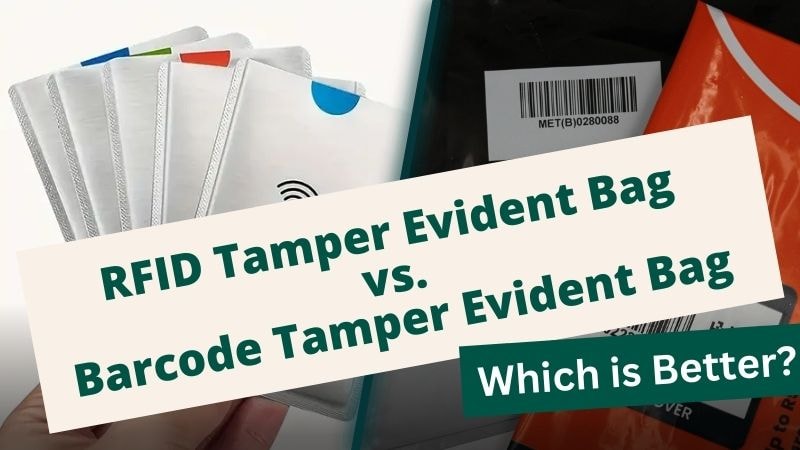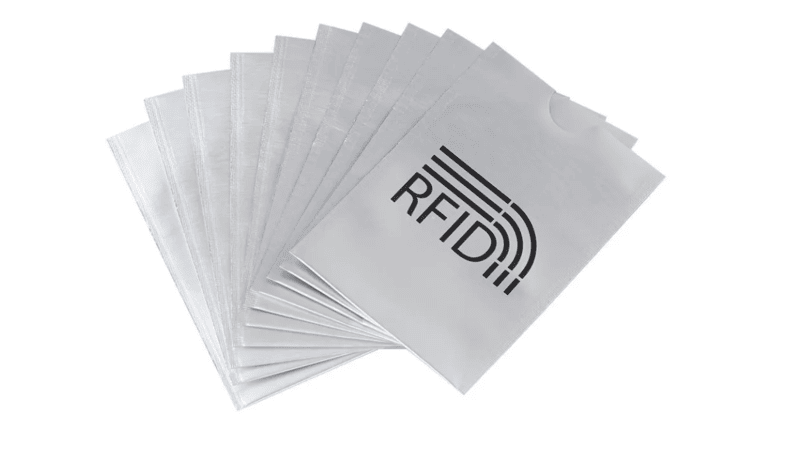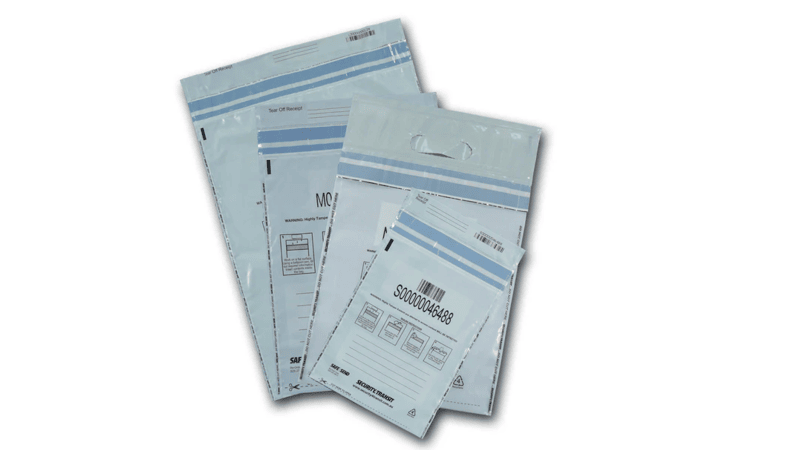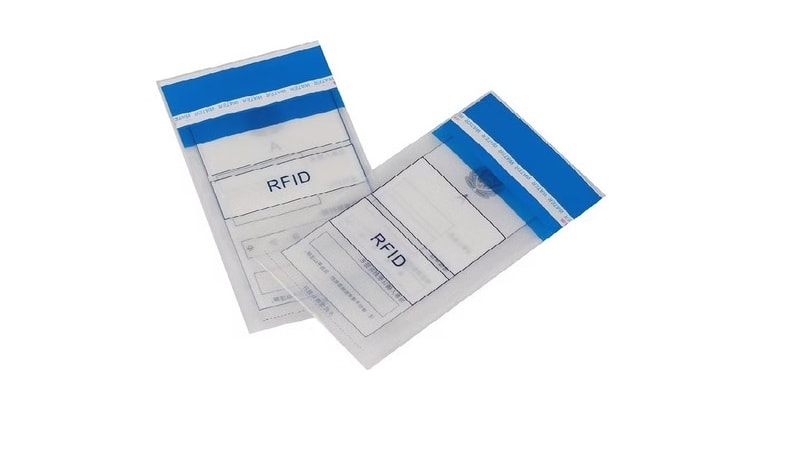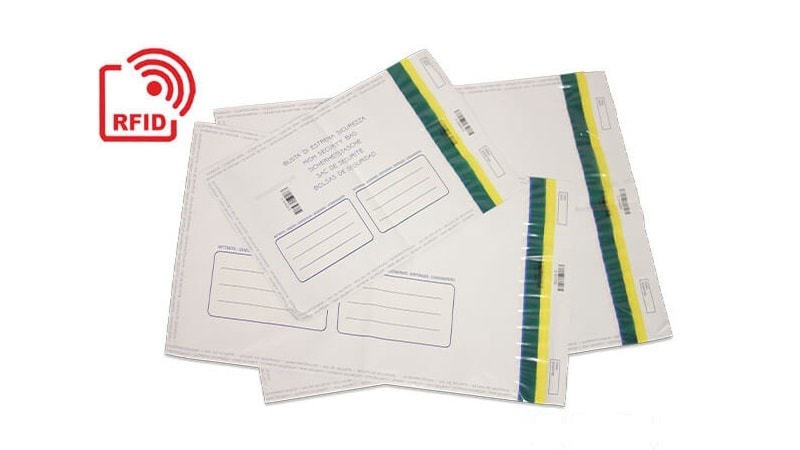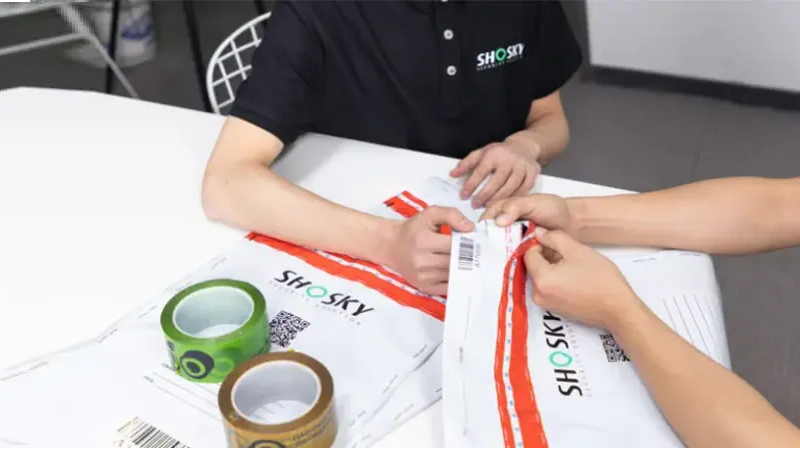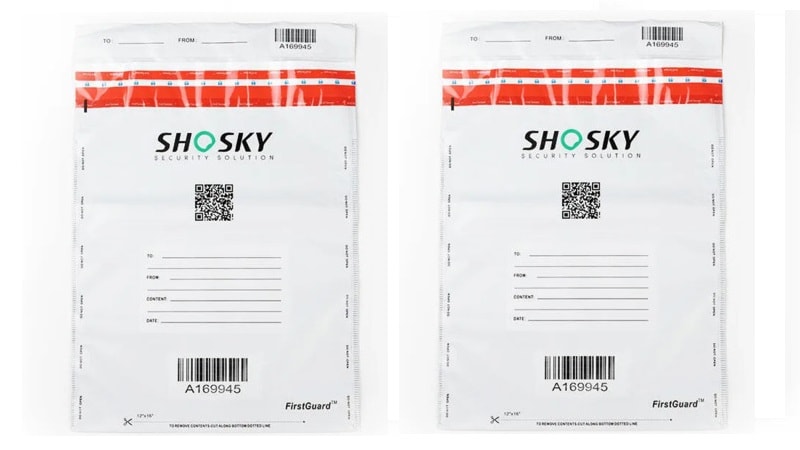When it comes to securing high-value shipments, businesses rely on tamper-evident bags. These bags help keep documents, cash, forensic evidence, and valuable items safe. However, tracking these bags requires a reliable system that ensures authenticity and traceability.
In this regard, RFID and barcode are two leading tracking technologies used in tamper-evident bags. In this article, we’ll analyze the key differences between them. Knowing these differences can help you pick the best tamper-evident solution for you!
What is an RFID Tamper-Evident Bag?
RFID stands for Radio Frequency Identification. It is a wireless technology that uses radio waves to send data between an RFID tag and a reader. This technology helps track items, verify authenticity, and enhance security.
When integrated with tamper-evident bags, RFID boosts security by allowing real-time tracking and automated package verification. Unlike traditional identification methods, RFID does not need direct line-of-sight scanning. This makes it more efficient and reliable for monitoring sensitive shipments.
Here is how RFID tamper-evident bags work:
- Embedded RFID Chips or Tags: Each bag contains an RFID tag or chip. They store unique identification data for tracking purposes.
- Wireless Data Transmission: The RFID tag communicates with RFID readers using radio waves. This helps with contactless scanning.
- Automated Data Capture: RFID readers capture the bag’s ID data in a matter of seconds. Then, they send it to a central system for verification.
- Tamper Detection: If someone tampers with the bag, the system will detect this action.
What is a Barcode Tamper Evident Bag?
A barcode tamper-evident bag is a security solution for tracking and protecting items. It uses a printed barcode security label to identify and monitor the contents within the bag. The barcode can be scanned to track the bag’s movement.
Barcodes store information such as serial numbers, shipment details, or security authentication data of a bag. When applied to tamper-evident bags, barcodes help maintain a verifiable chain of custody. They provide essential information about the bag’s contents, origin, or destination.
Here is how barcode tamper-evident bags work:
- Printed Barcodes: Each bag has a unique barcode. It can be a 1D, 2D, or QR code printed on the surface for easy identification.
- Scanning for Verification: Barcode readers or mobile scanners read the code. They retrieve and verify the bag’s information.
- Data Storage in Databases: The scanned barcode connects to a database. This database holds shipment details, security logs, and tracking records.
- Manual or Automated Tracking: Barcodes need line-of-sight scanning. This makes them suitable for both handheld and automated systems.
RFID vs. Barcode Tamper Evident Bags: Key Differences
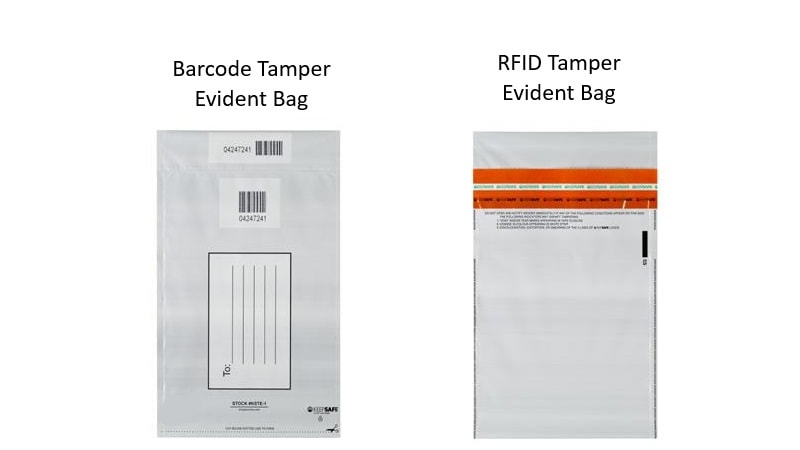
| Feature | RFID Tamper Evident Bags | Barcode Tamper Evident Bags |
|---|---|---|
| Technology | Uses radio waves to transmit data between RFID tags and readers | Uses printed barcodes (1D, 2D, or QR codes) that require optical scanning |
| Data Storage | Can store and update more complex data, including tracking history and security details | Stores limited information, usually a unique serial number or tracking ID |
| Scanning Method | Contactless scanning; multiple bags can be scanned simultaneously without direct visibility | Requires direct line-of-sight scanning, meaning each barcode must be individually scanned |
| Speed & Efficiency | Faster data retrieval, as RFID readers can process multiple tags at once | Slower, since each barcode must be scanned manually |
| Security | Offers real-time tracking and alerts if a bag is tampered with or removed from a secured area | Provides tamper evidence only when physically inspected; no automated alerts |
| Cost | Higher initial investment due to RFID chips, readers, and system integration | More affordable; requires only printed barcodes and standard barcode scanners |
| Durability | RFID tags can be embedded inside the bag, making them resistant to wear and environmental damage | Barcodes can be scratched, torn, or faded, making them harder to read over time |
| Use Cases | Ideal for high-security environments such as banking, law enforcement, and pharmaceuticals | Suitable for cost-conscious businesses and industries like shipping, inventory management, and retail |
| Integration | Can be linked with security systems, databases, and automated tracking platforms | Compatible with most inventory management and logistics systems without additional infrastructure |
| Tamper Evidence | Can detect unauthorized access automatically through RFID tracking systems | Provides visible tamper evidence if the barcode is removed or damaged |
Advantages of RFID for Tamper Evident Bags
RFID technology works great in high-security places. It can scan bags without touching them. Workers can track bags from far away. UHF RFID and fixed readers make this possible. This helps track many bags at once very quickly.
Real-time data transmission is another key advantage. The system updates information right away. When someone scans a bag, the system knows its exact location immediately. It can also tell if someone has tried to open the bag. This works well in places that need tight security. Hospitals, shipping companies, and banks rely on this technology.
Advantages of Barcodes for Tamper Evident Bags
Barcode-based tamper-evident bags are a more affordable option for businesses with tighter budgets. They are easy to install and can fit into existing systems. Barcodes are widely used, making them familiar and efficient for many organizations.
For small operations or low-risk areas, barcodes offer good security at a lower cost. They help businesses track inventory or shipments with efficiency. There is no need for real-time tracking or long-range scanning with barcodes.
Best Use Cases for RFID in Tamper-Evident Bags
Large-Scale, High-Value Items
RFID tamper-evident bags work well for industries that handle lots of high-value items. This includes luxury products, electronics, and cash. These bags provide enhanced security, protecting valuable items throughout the supply chain. The integration of passive RFID tags gives each bag a unique identifier.
This helps businesses track items during transport and storage. UHF RFID technology allows users to scan items from a distance. This is crucial for high-risk environments where tracking accuracy is critical.
The read range of RFID systems enables monitoring of items over large areas. This is particularly beneficial for global logistics companies using tamper technologies. It reduces the risk of theft or loss, even with large quantities of goods in transit.
RFID systems include fixed and mobile readers. These give each item a unique ID. This helps spot any tampering. This boosts both security and operational efficiency.
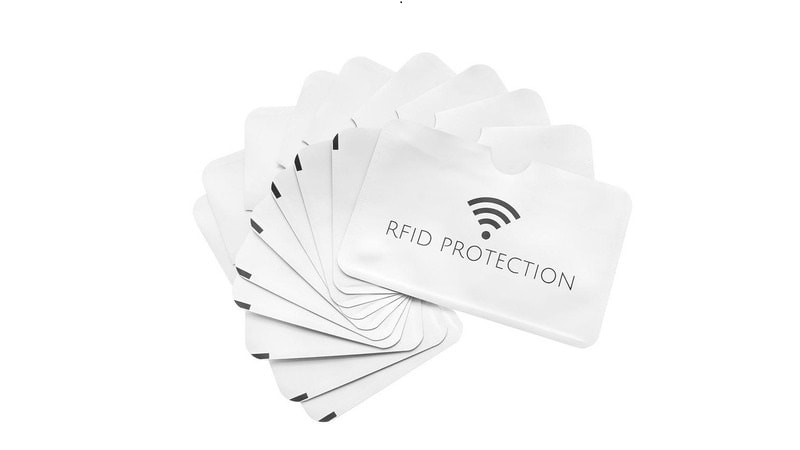
Situations Requiring High Security and Real-Time Tracking
RFID technology excels in environments requiring real-time tracking and high security. RFID systems continuously track tamper-evident bags, providing instant updates on status and location.
This level of real-time tracking is hard to replicate with traditional barcode systems. Thus, RFID is ideal for situations requiring strict security and quick responses.
Real-time tracking helps detect unauthorized access without delay. Security teams can respond without delay. RFID systems can alert you if someone opens a tamper-evident bag without permission.
Continuous monitoring strengthens security, especially in high-risk industries. This level of protection is crucial for safeguarding sensitive assets. RFID plays a key role in maintaining control and preventing security breaches.
Industries such as Pharmaceuticals, Electronics, and Logistics
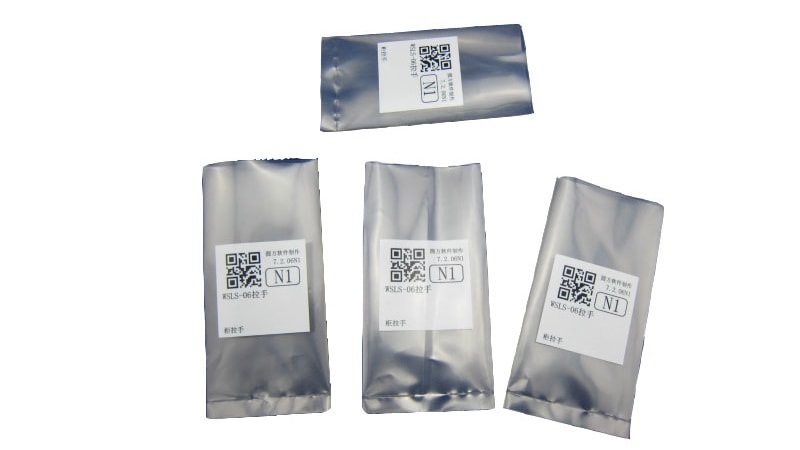
RFID tamper-evident bags are essential in sectors that need strict security and compliance. These industries include pharmaceuticals, electronics, and logistics. In medicine, these bags protect drugs during travel. They make sure medicine stays clean and safe. No one can touch the drugs without being noticed. The tracking chips show exactly where the medicine goes.
Electronics companies also rely on these bags. They ship expensive items that need careful watching. The chips in the bags track each product’s entire journey. Workers can see where items are at any moment. If someone tries to open the bag, an alert goes out. This keeps valuable goods secure from start to finish.
Best Use Cases for Barcodes in Tamper-Evident Bags
Smaller Businesses or Environments with Lower Security Needs
Barcode tamper-evident bags are cost-effective for smaller businesses. They are ideal for environments that don’t need the advanced features of RFID and can benefit from using simple security tapes. Companies with fewer high-value items or operating in low-risk environments often choose barcodes. The simplicity of barcode generators and standard scanners makes implementation easy and affordable.
For smaller operations, barcodes offer reliable security without the complexity of RFID. These bags fit well into existing processes. Many businesses already use barcodes for inventory management. Incorporating barcode-enabled tamper-evident bags requires no extra infrastructure or specialized training. This makes barcodes an effective tamper-evident solution that is affordable.
Cost-Conscious Operations Looking for a Simple Solution
Barcode tamper-evident bags are ideal for businesses looking for a simple solution. They offer a low-cost way to secure items without complex systems. The setup costs for barcode systems are much lower than for RFID. This makes barcodes a more affordable choice. They are perfect for organizations with tight budgets. Barcodes have broad recognition and are simple to put in place. They also provide an effective way to track and secure sensitive items. Best of all, barcodes cost far less than RFID solutions.
So, barcode bags are ideal for operations that don’t need advanced features. These tamper-proof solutions don’t need real-time tracking, read range, or mobile readers like RFID. For small warehouses or local shipping operations, barcodes offer enough security. They help prevent tampering and ensure monitoring throughout the journey. This simplicity makes barcodes a great choice. They provide a straightforward, budget-friendly solution for many businesses.
Applications like Inventory Management and Shipping
Businesses can use barcode tamper-evident bags for inventory management and shipping. They can scan barcodes to track item movement. The system keeps goods safe as they move through warehouses and distribution centers. It ensures that any tampering gets detected promptly. Barcodes are also effective in managing shipments during transit.
While RFID may offer more advanced features, barcodes remain a highly efficient option. They work well for businesses that prefer simpler, cost-effective tracking solutions. Barcodes are a simple yet reliable way to track shipments. They are easy to use and don’t need specialized infrastructure. For businesses with basic tracking needs, barcodes are often the best choice.
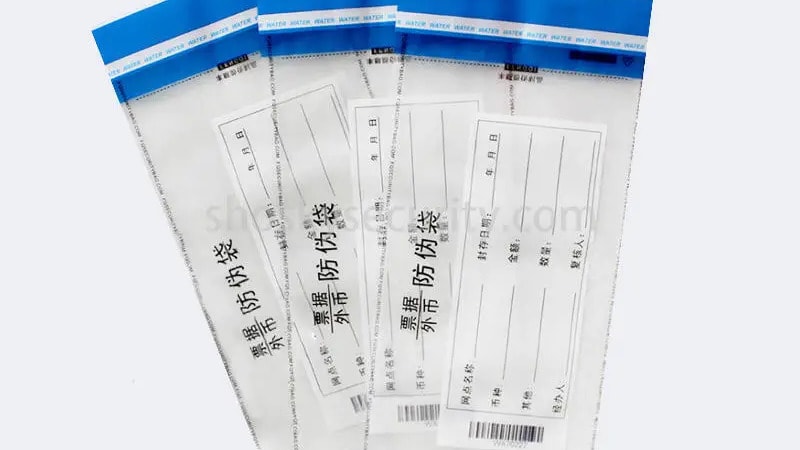
Which Technology is Better for Your Needs?
Choosing between RFID and barcode systems depends on several factors. They include the scale of operations, security requirements, and budget. Here are key factors to help you choose the best technology for your business.
Security and Tracking Needs
For high security and real-time tracking, RFID is usually the best option. RFID systems provide a higher level of security with continuous monitoring. This makes them ideal for industries where asset protection is critical, such as pharmaceuticals, electronics, and high-value logistics. RFID technology can track items in real time.
This offers instant updates on the status and location of each tamper-evident bag. The system also alerts users if someone opens or moves bags outside of their designated area. If your security needs are not strict and you only want to track items, a barcode system may be enough. Barcodes work well for businesses that don’t need real-time tracking. They are also useful when scanning items from afar isn’t necessary.
Scale of Operations
Business size matters when choosing the right bag. Large companies need better tracking tools. So, RFID works best for big operations. It can watch many goods at once. Workers can track items across different places with little effort. This helps manage big inventories quickly.
Small businesses have different needs. They might prefer simpler tracking methods. Barcodes work well for smaller operations. These systems are easy to use. Many companies already know how to use barcodes. They fit well with existing inventory systems.
Budget and Cost Efficiency
Money is always an important factor. Barcodes cost less to set up. They use cheap scanners and simple stickers. The equipment is much less expensive than RFID systems. Small businesses can track items without spending too much money.
RFID systems cost more at first. But they can save money later. Large companies might find them better in the long run. These systems track items faster and more accurately. They reduce extra work. RFID helps businesses run more smoothly and quickly.
Ease of Implementation
Barcode systems are quick and easy to use. They are especially simple if your business already uses barcodes for inventory management. Barcode readers also need minimal setup. So, if you are looking for a quick and straightforward solution, barcodes might be the way to go.
On the flip side, RFID systems take more time to set up. You may need to install a network of fixed readers and integrate software. Your team will need training to ensure the successful use of the new system. Yet, for larger businesses or those with complex needs, this investment can pay off over time.
Future Growth
Think about the future of your business. If you plan to expand or manage more goods, RFID might be the right choice. It is scalable and can grow with your business. RFID offers flexibility as your needs evolve. This makes it a great option for long-term growth.
On the other side, barcodes are helpful for many businesses, but they do not scale well. They may not keep up as your business grows or needs more advanced security. If you expect growth or need more security, RFID might be a wise long-term investment.
Hybrid Approach: Combining RFID and Barcode Technologies
RFID and barcodes provide enhanced security when used together. RFID excels in real-time tracking, long-range scanning, and data storage. Barcodes, on the flip side, are simple and cost-effective for inventory management. Together, they help businesses in tracking tamper-evident bags with security and affordability.
This combination boosts efficiency and flexibility. RFID tags track items across long distances, alerting staff to unauthorized access. Meanwhile, barcodes allow for quick item identification at key checkpoints. When used with other security measures, this hybrid system provides comprehensive protection. It keeps the contents safe and secure. This makes it a great choice for businesses.
FAQs
Are RFID tamper-evident bags more secure than barcode bags?
Yes! RFID bags offer enhanced security with real-time tracking and long-range monitoring. This makes them more secure than barcode bags.
Which is more cost-effective: RFID or barcode for tamper-evident bags?
Barcodes are more cost-effective. They need only printed labels and basic scanners. RFID has higher upfront costs due to chips, readers, and system setup. For businesses on a budget, barcodes offer a simpler and more affordable solution.
Can I retrofit existing tamper-evident bags with RFID tags or bar codes?
Yes, existing tamper-evident bags can be retrofitted with either RFID tags or barcodes to enhance tracking capabilities.
Conclusion
Both RFID and barcode tamper-evident bags offer effective solutions for securing high-value shipments. RFID offers real-time tracking and automation for high-security needs. Barcodes are simpler and cheaper, which is great for smaller operations. Regardless, businesses need to check their security needs, size, and budget to find the best option.
Keep Your Items Safe with Shosky Security Bags
For businesses seeking reliable tamper-evident solutions, Shosky Security offers high-quality options! We provide both RFID and barcode tamper-evident bags. With strong performance, Shosky ensures your valuable items stay secure throughout their journey. Contact us today for more details.
